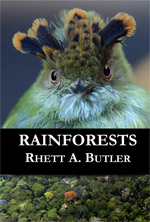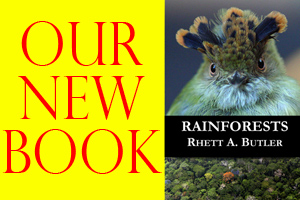
|
|
 |
Rainforests by Rhett Ayers Butler, founder and editor of mongabay.com An overview of tropical rainforests for kids, based on mongabay.com's popular web site for children (worldrainforests.com/kids). Rainforests describes tropical rainforests, why they are important, and what is happening to them. Rainforests, published in September 2011, is suitable for kids ages 10 and up as well as adults. Rainforests is available in two print formats: full-color and black-and-white. Each format is 94 pages with photos. (Ages 10 and up) |
 |
Monkey Magic: The Curse of Mukada by Grant S. Clark Are the orangutans of Mukada falling sick because there are just too many of them? Something doesn't sound right about the park warden's explanation, and eleven-and-a-half-year-old Romy discovers she has been given mysterious powers to work out why. An encounter with a prank-loving family of apes leads her to realize that she alone can help break a curse that has brought suffering to generations of orangutans. (Ages 9-12) |
 |
Discover the Amazon: The World's Largest Rainforest by Lauri Berkenkamp From avoiding predators to navigating through the jungle without a compass, this innovative guide provides kids with the vital tools one would need if lost in the Amazon. Offering practical survival techniques based on real stories, children will learn lessons that can be adapted to almost any outdoor situation, such as making fire, deciphering animal tracks, and using the natural world for all to create necessary supplies. Opening with an informative section on the region and its people, this essential resource combines history and science in a fun and engaging way. Facts and sidebars on the local creatures and plants are interspersed along with 15 activities for the home or classroom—from making a fishing spear to determining how much water is needed to stay healthy. (Ages 9-12) |
 |
Exploring the Rainforest: Science Activities for Kids by Anthony Fredericks and, Shawn Shea With practical, unique science activities focused on the rain forest, readers will be able to take a magical journey deep into the heart of the world's rain forests and learn firsthand about this incredible ecosystem. Full of hands-on activities, unbelievable facts, amazing discoveries, extraordinary adventures and fantastic experiments, this book makes any young person's journey into this mystical world all the more delightful. (Ages 9-12) |
 |
The Most Beautiful Roof in the World: Exploring the Rainforest Canopy Meg Lowman is a scientist who has spent years studying the rain forest canopy. Lasky and Knight join her in the treetops of Belize to record the wonders of plant and animal life found more than 100 feet above the ground. Yet, this book is not simply another chronicle of rain forest ecology, although the exceptional full-color photographs document with clarity the teeming life to be found there. Lasky also explains the methods scientists use to conduct research in this environment, sometimes under extremely difficult circumstances. For example, to gather leaf samples in Cameroon, Lowman had to hang over the edge of an inflatable raft suspended beneath a dirigible. (Ages 9-12) [School Library Journal] |
 |
The Great Kapok Tree: A Tale of the Amazon Rain Forest by Lynne Cherry Save the rain forest! The story itself is not overly compelling, but each personalized entreaty from the animals provides an accurate and persuasive scientific argument for preserving nature's gifts. Lynne Cherry's fertile watercolor and colored-pencil illustrations, including a map of the tropical rain forests of the world, are vivid and colorful. A fine starting point for a discussion about conservation. (Ages 4 to 8) [Amazon.com] |
 |
The Shaman's Apprentice: A Tale of the Amazon Rain Forest by Lynne Cherry and Mark J. Plotkin The author of The Great Kapok Tree (1990) takes us back to the Amazon rain forest, this time teaming up with ethnobotanist Plotkin. Together, they present a story in which a lesson about medicinal herbs is brought to life through young Kamanya, who dreams of becoming his tribe's next shaman. Kamanya spends his time following the current shaman into the forest and learning the secrets of the plants. But local plants can't cure the new diseases brought to the area by strangers, and the pills the strangers bring with them cause the indigenous people to lose faith in the ability of their shaman. Eventually a woman named Gabriella, who comes to study the properties of the rain forest plants, restores the tribe's faith. The lush illustrations make the story a visual pleasure. (Ages 5 to 9) [Booklist] |
 |
A Walk in the Rainforest by Kristin Joy Pratt Written and illustrated by a high school student, this environmental ABC presents ecological information for young audiences. Each letter features an animal or plant found in the rain forest with an explanatory paragraph. Interposing her factual material with warnings about endangered species, deforestation, and the harm coming to native peoples, Pratt presents her viewpoint without didacticism. The full-color illustrations done in watercolors, felt markers, and colored pencil show talent and concern. (Ages 4 - 8) [Eva Elisabeth Von Ancken] |
 |
One Day in the Tropical Rain Forest by Jean Craighead George It takes a few pages to catch the rhythm of naturalist George's new book, but once readers do, they'll find themselves drawn in. Set on the banks of the Orinoco River, the fictionalized tale chronicles the efforts of Tepui, an Indian boy, to help a group of scientists find a new species of butterfly, thereby saving the Venezuelan rain forest from being bulldozed into oblivion. The tension created by this literary device--which in the hands of a less skillful writer could have appeared contrived--adds considerable impact to this timely, well-wrought work. George imparts an amazing amount of information about these fast-disappearing tracts of land as she carefully describes the delicate ecological balance of exotic flora and fauna--from flesh-eating army ants to the vast colonies of butterflies that flutter high above the canopy of trees. Children will come away from this book not only with a satisfying story, but more importantly, with a clear understanding of why these areas are worth preserving. (Ages 9 - 12). [Publishers Weekly] |
 |
Tropical Rain Forest by Donald Silver Bats and big cats. Armies of ants. Squawking parrots. Strangling figs. From the ground up to the tree tops, the tropical rainforest teems with life. Stunning drawings, step-by-step experiments, fun-to-do activities, and fascinating facts abound in this magical exploration of an essential ecosystem, in danger of disappearing forever. (Ages 4-8) |
Adult-reading level
 |
A Teacher's Guide to a Walk in the Rainforest by Bruce Malnor and Carol Malnor A Teacher’s Guide to A Walk in the Rainforest. Based on Pratt-Serafini’s picture book favorite for rain forest study, this guide includes lessons about habitat, interdependency of species, the rain forest water cycle, native peoples, oxygen generation, and much more. |
 |
The New 50 Simple Things Kids Can Do to Save the Earth by Sophie Javna and The EarthWorks Group The world's a better place with EarthWorks Group's John Javna in it. He, along with his daughter, Sophie, help kids go from aware to active with simple (but inspiring) projects, tips, and little-known facts that puts a kid's own carbon footprint into perspective. In The New 50 Simple Things Kids Can Do to Save the Earth, Sophie and John have revised the original best-selling book for a concerned and vibrant Web 2.0 youth market. It's easy-to-do and kid-friendly projects show that kids can make a difference, and each chapter is packed with tons of links to groups and resources. What makes this book stand out, though, is that it doesn't just inform kids, it encourages them to make a difference by providing them, their friends and their families the tools to take action. |
 |
Stinging Trees and Wait-a-Whiles: Confessions of a Rainforest Biologist by William Laurance When Bill Laurance went to northern Australia in the mid-1980s, it was to study the teeming life of a classic rainforest. The problem was, the rainforest of Queensland, already limited in extent, was fast disappearing, logged and bladed into oblivion; even its legendary stinging trees, "a good hit [from which] can hurt for months," seemed in danger of becoming mere memories. Laurance's fieldwork became a running chronicle of what happens to the rainforest's creatures--tree kangaroos and vipers, redback spiders and pygmy possums, and countless other species that are little known outside the area--when once-unpeopled habitats are overrun. (One of the few species to benefit from the region's decline, Laurance observes, is the antechinus, a wolverine-like marsupial that thrives on disturbance.) Laurance soon realized, as he relates in his memoir, that he'd have to couple scientific information with activism in order to protect what little of the forest remained--activism that included recommending the area for a listing under the United Nations' World Heritage program, and that put him squarely at odds with the suspicious loggers who were his neighbors. Although confronted with death threats and an actual attempt on his life, Laurance pressed on, eventually winning over enough Queenslanders to launch a small but growing ecotourism industry. Well-written and often quite funny, Stinging Trees and Wait-a-Whiles will hearten any environmentalist and tropical traveler. (Ages 4 to 8) [Amazon.com] |
Date published: June 24, 2004 | Last updated: Dec 5, 2015


|
All about Rainforests
- About rainforests
- Rainforest animals
- Rainforest people
- Why are rainforests important?
- Why are rainforests disappearing?
- How can we save rainforests?
Sponsor(s)
FAQs
|
|
home | teacher resources | rainforest books for kids | other languages | about the site | main rainforest site | help support the site | search | contact worldrainforests.com/kids is published under a creative commons license.  
©2004-2019 mongabay.com |
